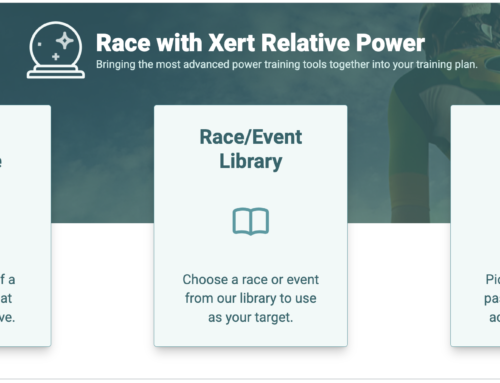Workout Design
Interval training is a staple of many athletes’ training regimens, but designing the right workout can often feel like a mix of science and art. Coaches must consider a range of factors—fitness level, fatigue, and motivation—while relying on experience and intuition to craft effective sessions. However, with the advent of Xert’s MPA (Maximal Power Available) analysis, much of the guesswork is removed, making it easier to design workouts that are both effective and personalized to each athlete’s unique fitness profile.
In this post, we’ll explore how MPA can be used to design more precise interval training sessions, offering athletes consistent feedback and optimized workouts based on their current fitness signature.
For comparison purposes, we will use the Xert Workout Designer, which includes MPA analysis, to compare and contrast various workout designs. As an example, we can design a standard, VO2max workout often used in training – 5 x 5 min VO2max intervals:

The workout starts with a warmup and prep interval, then has 5 intervals with 5 minutes at 115% of Threshold Power (TP) and 5 minutes at 55% TP. Applying this workout against a sample signature of TP = 250 W, High Intensity Energy (HIE) = 25.0 kJ and Peak Power (PP) = 1200 W, we graph both power (multicoloured line) and the MPA (magenta line).
By comparing power with MPA, the athlete would be able to perform the workout successfully, albeit the end of each 5 minute high-intensity interval would be quite difficult as their MPA approaches their power output.

Let’s now consider a different athlete, with fitness signature parameters of TP = 240 W, HIE = 25.0 kJ and PP = 1000 W:
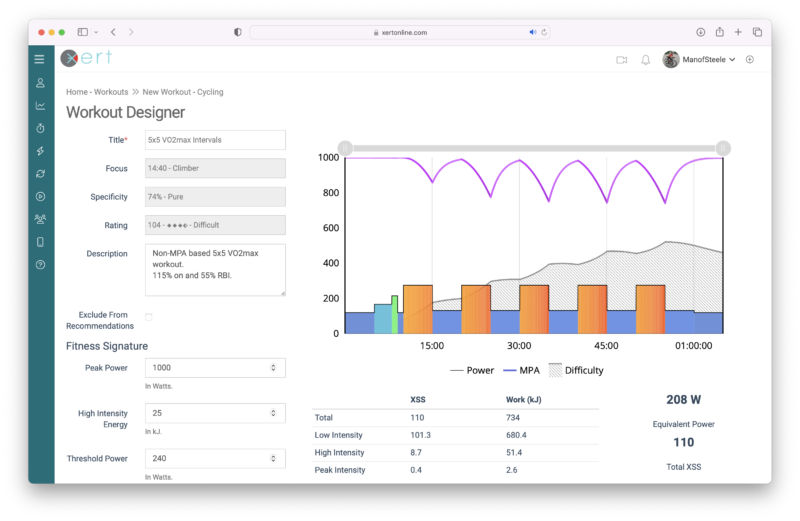 We can see that for this athlete, the workout would be much easier to perform. With more High Intensity Energy and a lower relative Threshold Power, the targets would be lower and would not be as difficult for the athlete to perform. One might increase the power targets for this athlete, relative to TP.
We can see that for this athlete, the workout would be much easier to perform. With more High Intensity Energy and a lower relative Threshold Power, the targets would be lower and would not be as difficult for the athlete to perform. One might increase the power targets for this athlete, relative to TP.
Consider a third athlete with TP = 340 W, HIE = 15.0 kJ and PP = 1000 W:
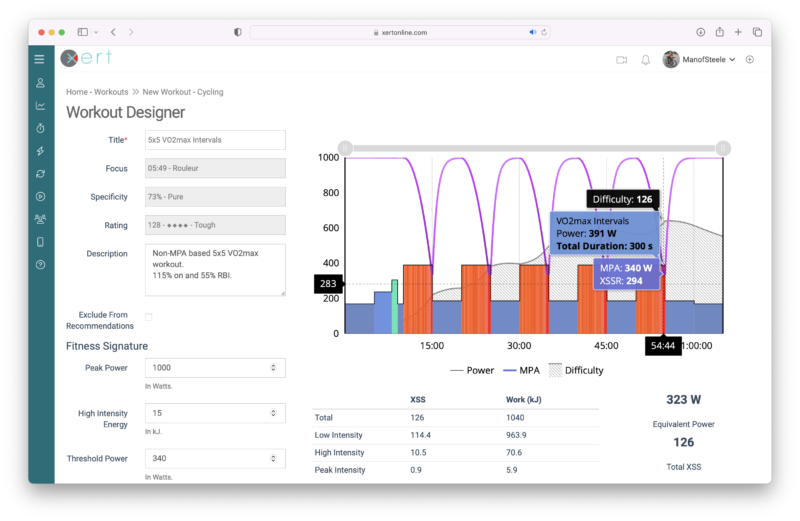
This athlete would find the workout impossible to perform since they would not have sufficient power left to hold the require power by the end of each 5 minute interval. That is, MPA is less than the power target. This athlete may in fact, abandon the workout given its difficulty.
Using Target MPAs
Xert’s Workout Designer enables the ability to use a novel method for the assignment of interval intensity. Rather than setting the workout intensity to be a fixed value, an intensity can be calculated that is specific to each athlete’s unique fitness signature. To do this, the intervals are designed to have the athlete reach (or recover to) a particular level of fatigue by the end of the interval duration.
Let’s look at another VO2max-based workout, designed using MPA targets rather than fixed intensity. Below you will find the SMART – Elastic Heart – 3.5 workout:

In the designer we use the same interval duration but define interval intensity to be an MPA value. The interval target MPA for the workout is defined as 60% Reserve MPA, that is 60% of the difference between PP and TP. The recovery interval intensity is defined as 99% Peak Power MPA, or nearly fully recovered.

For the first athlete, this workout would be quite similar to the standard 5 x 5 workout design. For the second athlete, with TP = 240W, HIE = 25kJ and PP = 1000W, this workout becomes more difficult as it brings them to a deeper point of fatigue:
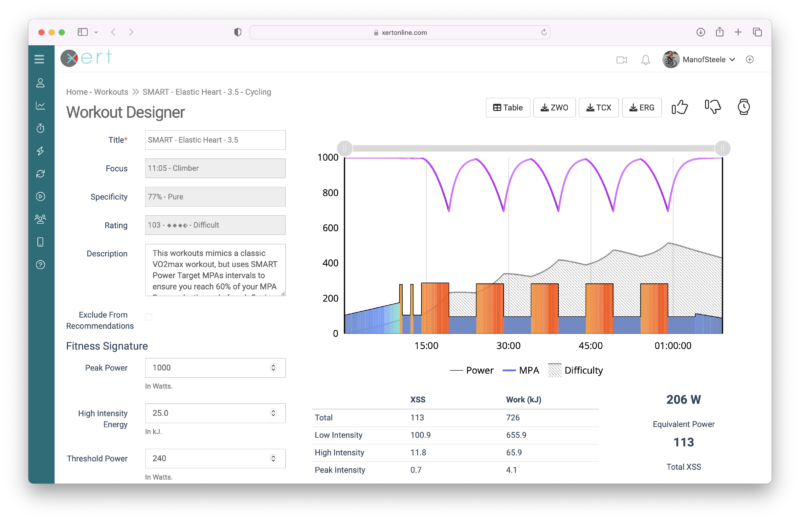
For the last athlete, where the standard 5 x 5 VO2max workout was not achievable, this new workout is:

The workout was designed as 3.5 diamond difficulty (e.g. Difficult), meaning that the intent was not to bring the athlete too deep into fatigue in order to make it a workout that they can complete without requiring a great deal of motivation. If on the other hand, a more strenuous workout was sought, the user might consider the SMART – Elastic Heart – 4.0 workout, in which the MPA targets are deepened, thus making the workout more difficult:
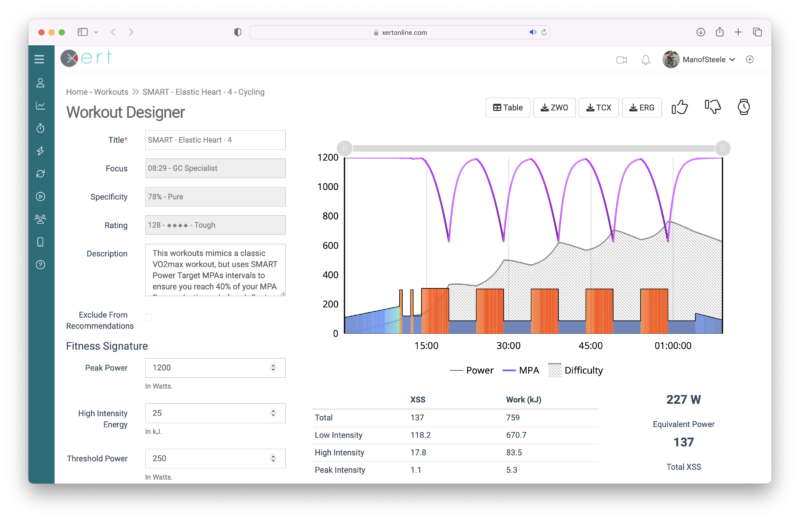
Additionally, we can lighten the efforts if the athlete would still like to perform a VO2max workout but may not have the same motivation on a given day. Below is SMART – Elastic Heart – 3.0:
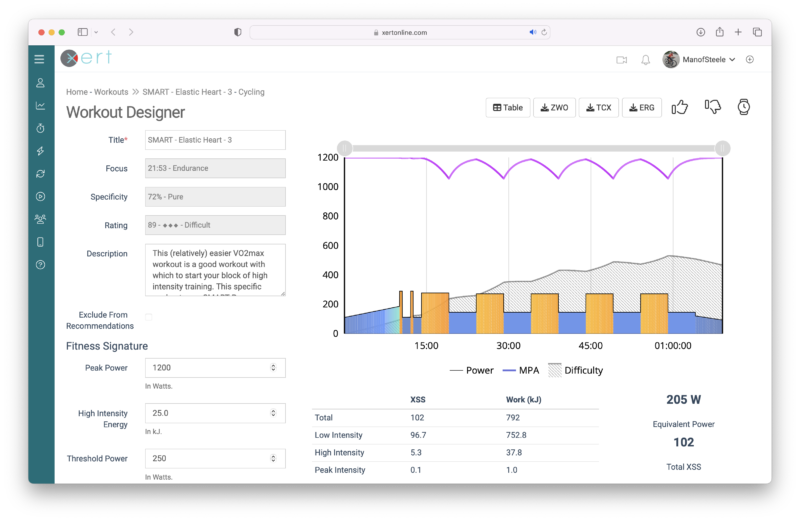
By using MPA targets rather then fixed power intervals, Xert’s Workout Designer provides a convenient and flexible way to create and optimize workouts based on the unique characteristics of each individual athlete and the level of training and/or motivation they may have on a given day.


